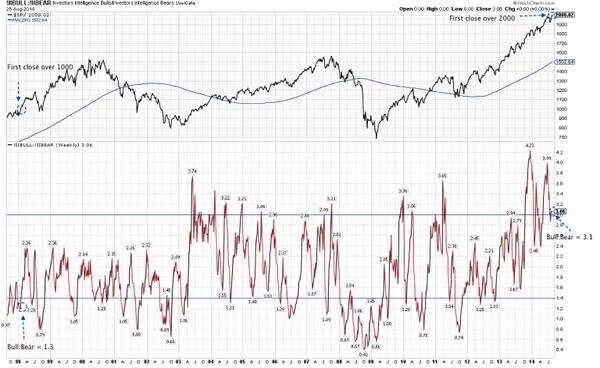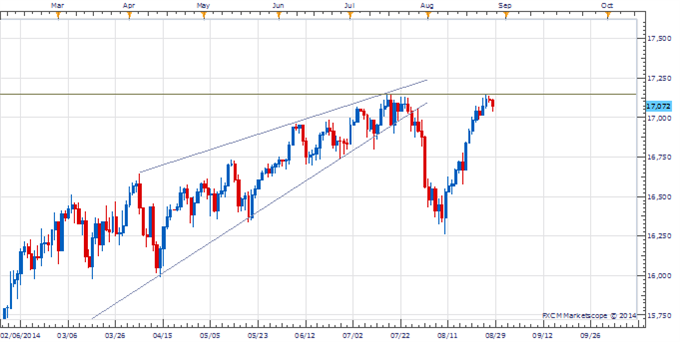Summary – A top-down review of interesting calls and comments made last week about monetary policy, economics, stocks, bonds & commodities. TACs is our acronym for Tweets, Articles, & Clips – our basic inputs for this article.
Editor’s Note: In this series of articles, we include important or interesting Tweets, Articles, Video Clips with our comments. This is an article that expresses our personal opinions about comments made on Television, Tweeter, and in Print. It is NOT intended to provide any investment advice of any type whatsoever. No one should base any investing decisions or conclusions based on anything written in or inferred from this article. Macro Viewpoints & its affiliates expressly disclaim all liability in respect to actions taken based on any or all of the information in this article. Investing is a serious matter and all investment decisions should only be taken after a detailed discussion with your investment advisor and should be subject to your objectives, suitability requirements and risk tolerance
1. We were wrong about Draghi
Last week we wrote “We are not sure what some expected from Draghi. But they were disappointed a bit by it” and we showed a chart of the Euro bouncing after his talk. This week, the European markets showed us we were wrong by rallying big on Monday and following up on that rally on Tuesday & Wednesday. Now every one is focused on whether European QE or promises of European QE are delivered at next Thursday’s ECB meeting.
This entire rally from August 2012 has been driven by promises by Draghi and the market’s confidence in his ability to deliver at some stage. So we were wrong to scoff at his speech on Friday. While European equity markets are patient, the German Bund market is not. In a stunning week, the yield on the 10-year German Bund fell 10%, by 9.3 bps to 88.5 bps from 97.5 bps last week. What does that say about Germany’s economy?
- Wednesday – NDR – Ominous signs for Europe’s most important economy? @NDR_Research @NDREurope pic.twitter.com/AoUjHfrhRJ

GaveKal identified “six countries, all in Europe, where the year-over-year change in consumer prices is basically zero (Switzerland, Sweden) or there is currently outright deflation in consumer prices“.
So the markets may be correct in expecting monetary cavalry like European QE to rise to the rescue next week. But what does Germany’s finance minister say?
- Friday – Francine Lacqua @flacqua Schaeuble: ECB’s monetary policy can’t fight deflation http://bloom.bg/1sQWapB
We would rather you listen to this anti-Fed like blasphemy from Herr Schaeuble himself in this 01:30 minute clip.
2. Treasury yields
Rick Santelli and others have maintained for some time that Treasuries are a terrific relative value bet vs. falling European yields. David Rosenberg has been somewhat skeptical but this Friday he threw in the proverbial towel:
- “The “new normal” is that U.S. Treasury yields are more tightly linked to market rates in Europe than they are to domestic economic trends.”
This followed his comment on Thursday:
- “only a fool would now stand in front of either train, as difficult as it may be to explain how a 2-handle in Treasury yields can possibly coexist with a 2k-handle in the S&P 500″.
CNBC kept talking about the S&P but the real action this week, just like all year, was in the 30-year Treasury. TLT rallied by 1.47% on the week vs. 84 bps on the S&P. The 30-year yield fell by 8 bps this week compared to the 3 bps fall in the 5-year consistent with the strongest trend of 2013 – “unrelenting, unrepentant” flattening of the 30-5 year yield curve. No doubt many felt what one verbalized during Thursday’s fall in the 30-year yield:
- Thursday – Jeff Chmielewski @JeffCNYC Long bond totally perplexing.
- Peter Tchir @TFMkts – at 3.30% everyone hated the long bond (yet again), now at 3.06% seeing more bulls $tlt $TBT
And you have the channel again:
- Thursday – Helene Meisler @hmeisler @CapitalObserver Here you go. pic.twitter.com/f87TcQQ6xK

But remember what rules the roost in the very short term? – Ukraine. We think Pres. Putin is pretty much in control & Pres. Obama almost admitted as such. But if more crap happens in Ukraine over this long weekend, then the channel could be penetrated next week just as Russ-Ukraine border was this week.
Think back two weeks ago to August 15 when the news of a Russian convoy destroyed by Ukraine roiled the markets causing the 10-year yield to touch 2.31%. We think what has happened to the Treasury curve since August 15 is instructive:
- 30-yr yield 3.08% on 8/29 vs. 3.13% on 8/15; 10-yr yield 2.34% on 8/29 & 2.34% on 8/15; 5-year yield 1.63% on 8/29 vs. 1.54% on 8/15; 3-yr 93 bps on 8/29 vs. 87 bps on 8/15; 49 bps on 8/29 vs. 41 bps on 8/15.
The 2-5 year curve has shot up in yield because of Yellen’s comments and stronger data but the 30-year yield has fallen. Is this all Europe & European deflation? Or is that a signal of something rotten in our own little economy? In one way, this supports the call by Rick Rieder for a “policy transition announcement at the Fed’s September meeting“. Rieder argued that the action in the long maturity treasuries gives cover to the Fed to start signalling earlier rate hike. But, per Gundlach, the action in the long bonds argues against any such move by the Fed. Recall what Gundlach emphatically said on Friday, August 15:
- “Yellen doesn’t want to raise interest rates … Fed follows long end of the bond market; Fed doesn’t tighten while long rates are falling”
Perhaps, next week’s payroll report will clear things up.
3. U.S. Stock market
What was the worry about seasonality?
- Wednesday – Ryan Detrick, CMT @RyanDetrick So August is usually weak and the week before Labor Day is also weak. Looking at 2nd best Aug in 15 years and no weakness this week. Hmmm.
So will we once again say “hmmm” a month from now or will September prove its “worst month” label this year?
- Tuesday Jason Goepfert @sentimentrader – When $SPX was up >3% in August and at 12-month high, September was up only 1 out of 12 attempts.
The week began predictably on Fin TV with Jeremy Siegel being bullish with 19,000 Dow possibility. Tim Seymour on CNBC FM dismissed his 2100 S&P target as no big deal since it was only 5% higher; Ari Wald, OPCO technician, stated his 2080 target and pronounced Halliburton as his chosen stock for year-end. Carter Worth, ex-OPCP technician, coined the “unrelenting, unrepentant” bull comment (that we used above for the flattening of the 30-5 yr yield curve) for the stock market.
But even bulls were talking about sentiment by the end of the week.
- Thursday – Ryan Detrick, CMT @RyanDetrick – Here come the bulls. NAAIM up 38% last week (57 to 79), largest weekly jump in six months. $SPY http://stks.co/b0wX9

and,
- Urban Carmel @ukarlewitz – When SPX broke 1000, Investors Intelligence Bull:Bear was 1.3x. When it broke 2000, it was 3.1. Hated 1000; love 2000

Jeff Saut expressed some caution on Friday:
- “By my work, despite the fact the stock market’s internal energy is totally used up, the equity markets should “hold” into next week where another downside test is due.”
Jim Paulsen, a proven bull, remains not so in the short term:
- Thursday Carl Quintanilla @carlquintanilla – Jim Paulsen still sees $SPX 1850 by year-end, as improving economy ignites inflation/rate fears. @CNBC @SquawkStreet
Kristian Kerr of DailyFX on Thursday about his focus chart of the week below:

- Since the start of the year I have been writing about the mid-July to early September period and its potential to mark some sort of important inflection point in US stocks. The Dow put in a peak almost exactly in the middle of July and then sold off 5% over three weeks. I take this action as a sign that the cyclical analysis is on point. Heading into the end of this key cyclical period the Dow is right back at new highs. While most see this as positive, I see it as quite dangerous and setting us up potentially for some kind of secondary high as this key “turn window” closes. If we do get a clear high next week I think the stock market is in for a rocky few months.
Harking back to the Dukes,
- Wednesday Lawrence McDonald @Convertbond – Sell Mortimer Sell! Price to Sales ratio of 1.76, highest since April 2002, 16% higher than the average since 1995 pic.twitter.com/a5xqsD2Nz5

The credit for the boldest call of the week goes to technician Abigail Doolittle who, to the expressed scorn of her (CNBC Closing Bell) segment-mate Jack Bouroudjian, talked about a 50%-60% decline ahead in the US stock market.
And credit for the most interesting & new measure of overvaluation goes to Charles Biderman who said the following this week on CNBC’s Santelli Exchange:
- “stocks are growing 25% a year; wages & salaries are growing 3% a year;one doesnt justify the other;If you look at the relationship between wages and salaries and the market cap, it’s like 3.5 times, … The last two times it was close to this was in March of 2000 and October 2007.” it went to 3.7-3.8”
Last week, sentiment on emerging markets ranged from a contrarian sell signal to a “its a good time to put money anywhere in emerging markets”. This week, heard nothing but “unrelenting, unrepentant” bullishness about emerging markets on CNBC Options Action. Their resident technician, Carter Worth, likes EEM on both absolute & relative basis and gave his target as $50-$52.
4. Commodities
One of the best rallies was in energy this week. USO was up 2.5% this week and UNG, the natural gas, ETF was up 5% confirming the call made by Larry McDonald some time ago and by Dennis Gartman this week on CNBC FM. Gartman thinks natural gas could rise to $5 in a few months.
Send your feedback to editor@macroviewpoints.com Or @MacroViewpoints on Twitter